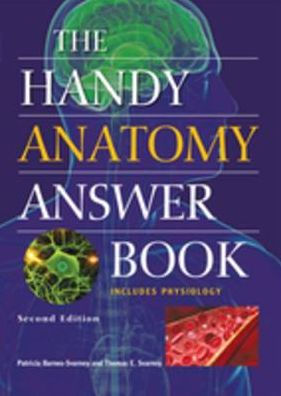
The Handy Anatomy Answer Book
386
The Handy Anatomy Answer Book
386eBookSecond Edition (Second Edition)
Related collections and offers
Overview
We all have one. The human body. But do we really know all of its parts and how they work? The Handy Anatomy Answer Book is the key to unlocking this door to a wondrous world. Learn how the body heals wounds. Untangle the mysteries of eyesight. Discover how cells organize themselves into organs and other tissues. From the violent battleground that is the immune system to the hundreds of miles of muscle fibers, nerves, veins, and arteries that fill our bodies, the human is a miracle waiting to be explored.
The Handy Anatomy Answer Book covers all the major body systems: integumentary (skin, hair, etc.), skeletal, muscular, nervous, sensory, endocrine, cardiovascular, lymphatic, respiratory, digestive, urinary, and reproductive, and, for good measure, adds chapters on growth and development and how science can help and augment the body. It follows the fascinating maze of organ systems and shows how much the body does routinely just to let you move, breathe, eat, and fight off disease. Fascinating trivia, along with serious facts, combine to answer over 1,200 questions about the human body, including …
A glossary and index are included, along with nearly 120 color illustrations, detailed medical charts and photographs help supplement the text. This handy reference helps make the language of anatomy—as well as physiology and pathology—more understandable and less intimidating. The Handy Anatomy Answer Book is an engaging look at the topic, the historic development of the science, the personalities behind the research, and the latest controversies and scientific advancements.

Product Details
| ISBN-13: | 9781578595891 |
|---|---|
| Publisher: | Visible Ink Press |
| Publication date: | 01/18/2016 |
| Series: | The Handy Answer Book Series |
| Sold by: | Barnes & Noble |
| Format: | eBook |
| Pages: | 386 |
| File size: | 22 MB |
| Note: | This product may take a few minutes to download. |
About the Author
Thomas E. Svarney is a scientist who has written extensively about the natural world. His books, with Patricia Barnes-Svarney, include Visible Ink Press’ The Handy Dinosaur Answer Book, The Handy Math Answer Book, and The Handy Ocean Answer Book, and he is also the author of Skies of Fury: Weather Weirdness around the World and The Oryx Guide to Natural History.
Table of Contents
Acknowledgments ix
Photo Credits x
Introduction xi
History of Anatomy 1
Defining Anatomy 1
Studies in Anatomy 2
Comparing Other Organisms 7
Anatomy and Biology Basics 9
Human Anatomical Terminology 9
Chemistry in Biology and Anatomy 12
Biological Compounds and the Human Body 15
Comparing Other Organisms 18
Levels of Organization 21
Defining Levels of Organization in Anatomy 21
Cells 22
Tissues 31
Organs and Organ Systems 38
Homeostasis 40
Comparing Other Organisms 41
Sensory System 43
Smell 46
Taste 48
Hearing 50
Vision 55
Comparing Other Organisms 63
Integumentary System 67
Introduction 67
Skin Structure 68
Skin Function 75
Nails 78
Hair 79
Accessory Glands 82
Comparing Other Organisms 84
Skeletal System 87
Introduction 87
Bone Basics 89
Axial Skeleton 93
Appendicular Skeleton 98
Joints 102
Comparing Other Organisms 107
Muscular System 109
Introduction 109
Organization of Muscles 112
Muscle Structure 116
Muscle Function 120
Comparing Other Organisms 126
Nervous System 129
Introduction 129
Neuron Function 131
Central Nervous System 136
The Brain 139
Spinal Cord 145
Peripheral Nervous System: Somatic Nervous System 146
Peripheral Nervous System: Autonomic Nervous System 150
Learning and Memory 151
Sleep and Dreams 154
Comparing Other Organisms 159
Endocrine System 163
Introduction 163
Hormones 164
Pituitary Gland 167
Thyroid and Parathyroid Glands 171
Adrenal Glands 176
Pancreas 178
Pineal Gland 182
Reproductive Organs 182
Other Sources of Hormones 184
Comparing Other Organisms 186
Cardiovascular System 189
Introduction 189
Blood 190
The Heart 198
Bloodvessels 202
Circulation 205
Comparing Other Organisms 208
Lymphatic System 211
Introduction 211
Lymphatic Vessels and Organs 214
Nonspecific Defenses 217
Specific Defenses 218
Allergies 226
Comparing Other Organisms 229
Respiratory System 231
Introduction 231
Structure and Function 232
Respiration and Breathing 239
Sound Production 243
Comparing Other Organisms 244
Digestive System 247
Introduction 247
Upper Gastrointestinal Tract 248
Lower Gastrointestinal Tract 255
Accessory Glands 260
Metabolism and Nutrition 265
Comparing Other Organisms 272
Urinary System 275
Introduction 275
Kidneys 276
Accessory Organs 281
Urine and Its Formation 282
Comparing Other Organisms 283
Reproductive System 285
Introduction 285
Male Reproductive System 286
Female Reproductive System 292
Conception 298
Sexually Transmitted Diseases 301
Comparing Other Organisms 302
Human Growth and Development 303
Introduction 303
Prenatal Development-Embryonic Period 304
Prenatal Development-Fetal Stage 309
Birth and Lactation 313
Postnatal Development 318
Comparing Other Organisms 322
Helping Human Anatomy 325
Anatomy and Imaging Techniques 325
Diagnostic Techniques for Various Systems 329
Operations, Procedures, and Transplants 335
Comparing Other Organisms 340
Further Reading 341
Glossary 345
Index 351
